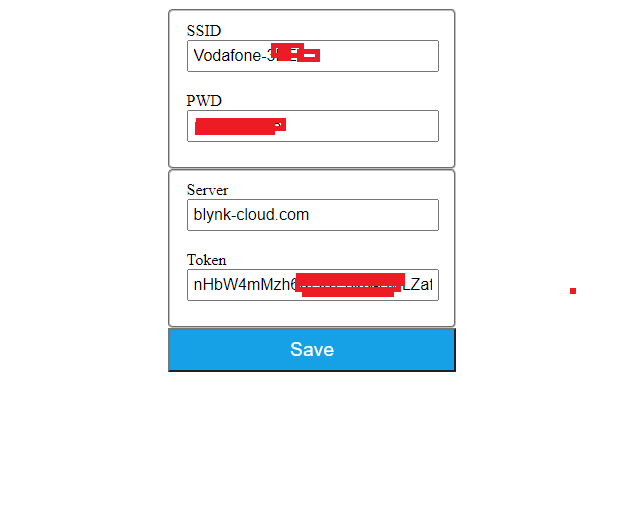SOLVED (blynk older library version working good)
Hello, i spend 3 days to search over internet to get my arduino mega wemos working with autoconnect function, once i get it working i was very happy, but then i start to add dht sensor, and can’t understand what i’m doing wrong, i add antenna to my arduino for good connection and also tried with mobile hotspot, i din’t relly found similar topics about arduino mega + esp8266 with similar problems.
• Hardware model = Wemos® Mega + WiFi R3 ATmega2560 + ESP8266 32Mb
• Smartphone = Android 10
• Blynk server or local server = local and blynk server
• Blynk Library version = 0.6.1 (when i updated to this 1.0.0 beta 3 i get errors)
CODE:
#define BLYNK_PRINT Serial
// Debug level, 0-3
#define BLYNK_WM_DEBUG 1
#define USE_NEW_WEBSERVER_VERSION true //false
#define _ESP_AT_LOGLEVEL_ 0
#define _ESP_AT_LIB_LOGLEVEL_ 0
/* Comment this out to disable prints and save space */
#define ESP_AT_DEBUG_OUTPUT Serial
//#define ESP_AT_LIB_DEBUG_OUTPUT Serial
#define ESP_AT_DEBUG true
#define ESP_AT_LIB_DEBUG true
/* Comment this out to disable prints and save space */
#define DRD_GENERIC_DEBUG true
// Uncomment to use ESP32-AT commands
//#define USE_ESP32_AT true
// USE_ESP_AT_LIB == true to use new ESP_AT_Lib, instead of ESP8266_Lib
// For ESP32-AT, must use ESP_AT_Lib
#if (defined(USE_ESP32_AT) && USE_ESP32_AT )
#define USE_ESP_AT_LIB true
#else
#define USE_ESP_AT_LIB true
//#define USE_ESP_AT_LIB false
#endif
//#if !( defined(ARDUINO_AVR_MEGA) || defined(ARDUINO_AVR_MEGA2560) || defined(ARDUINO_AVR_ADK) )
#if !( defined(__AVR_ATmega2560__) || defined(__AVR_ATmega2561__) || defined(__AVR_ATmega1280__) || defined(__AVR_ATmega1281__) || \
defined(__AVR_ATmega640__) || defined(__AVR_ATmega641__) || defined(ARDUINO_AVR_MEGA2560) || defined(ARDUINO_AVR_MEGA) )
#error This code is intended to run only on the Arduino Mega 1280/2560/ADK boards ! Please check your Tools->Board setting.
#endif
// For Mega, use Serial1 or Serial3
#define EspSerial Serial3
#if ( defined(ARDUINO_AVR_MEGA2560)|| defined(__AVR_ATmega2561__) )
#define BOARD_TYPE "AVR Mega2560"
#elif ( defined(__AVR_ATmega1280__) || defined(__AVR_ATmega1281__) )
#define BOARD_TYPE "AVR Mega1280"
#elif defined(ARDUINO_AVR_ADK)
#define BOARD_TYPE "AVR MegaADK"
#else
#define BOARD_TYPE "AVR Mega"
#endif
#ifndef BOARD_NAME
#define BOARD_NAME BOARD_TYPE
#endif
// Start location in EEPROM to store config data. Default 0
// Config data Size currently is 128 bytes)
#define EEPROM_START 0
#define USE_BLYNK_WM true
//#define USE_BLYNK_WM false
#if USE_BLYNK_WM
#include <BlynkSimpleShieldEsp8266_WM.h>
#else
#include <BlynkSimpleShieldEsp8266.h>
#define USE_LOCAL_SERVER true
#if USE_LOCAL_SERVER
char auth[] = "****";
char BlynkServer[] = "account.duckdns.org";
//char BlynkServer[] = "192.168.2.112";
#else
char auth[] = "****";
char BlynkServer[] = "blynk-cloud.com";
#endif
#define BLYNK_SERVER_HARDWARE_PORT 8080
// Your WiFi credentials.
char ssid[] = "****";
char pass[] = "****";
#endif
// SSID and PW for Config Portal
char portal_ssid[] = "Gunar";
char portal_password[] = "1122334455";
// Your Mega <-> ESP8266 baud rate:
#define ESP8266_BAUD 115200
ESP8266 wifi(&EspSerial);
#if USE_BLYNK_WM
#define BLYNK_PIN_FORCED_CONFIG V19
#define BLYNK_PIN_FORCED_PERS_CONFIG V20
// Use button V10 (BLYNK_PIN_FORCED_CONFIG) to forced Config Portal
BLYNK_WRITE(BLYNK_PIN_FORCED_CONFIG)
{
if (param.asInt())
{
Serial.println( F("\nCP Button Hit. Rebooting") );
// This will keep CP once, clear after reset, even you didn't enter CP at all.
Blynk.resetAndEnterConfigPortal();
}
}
// Use button V20 (BLYNK_PIN_FORCED_PERS_CONFIG) to forced Persistent Config Portal
BLYNK_WRITE(BLYNK_PIN_FORCED_PERS_CONFIG)
{
if (param.asInt())
{
Serial.println( F("\nPersistent CP Button Hit. Rebooting") );
// This will keep CP forever, until you successfully enter CP, and Save data to clear the flag.
Blynk.resetAndEnterConfigPortalPersistent();
}
}
#endif
//#include <ESP8266_Lib.h>
//#include <BlynkSimpleShieldEsp8266.h>
#include <DHT.h>
#define DHTPIN 40
#define DHTTYPE DHT11
DHT dht(DHTPIN, DHTTYPE);
BlynkTimer timer;
void sendSensor()
{
float h = dht.readHumidity();
float t = dht.readTemperature(); // or dht.readTemperature(true) for Fahrenheit
if (isnan(h) || isnan(t)) {
Serial.println("Failed to read from DHT sensor!");
return;
}
// You can send any value at any time.
// Please don't send more that 10 values per second.
Blynk.virtualWrite(V5, h);
Blynk.virtualWrite(V6, t);
}
void heartBeatPrint()
{
static int num = 1;
if (Blynk.connected())
{
Serial.print(F("B"));
}
else
{
Serial.print(F("F"));
}
if (num == 80)
{
Serial.println();
num = 1;
}
else if (num++ % 10 == 0)
{
Serial.print(F(" "));
}
}
void check_status()
{
static unsigned long checkstatus_timeout = 0;
#define STATUS_CHECK_INTERVAL 15000L
// Send status report every STATUS_REPORT_INTERVAL (60) seconds: we don't need to send updates frequently if there is no status change.
if ((millis() > checkstatus_timeout) || (checkstatus_timeout == 0))
{
// report status to Blynk
heartBeatPrint();
checkstatus_timeout = millis() + STATUS_CHECK_INTERVAL;
}
}
void setup()
{
// Debug console
Serial.begin(115200);
while (!Serial);
delay(500);
Serial.print(F("\nStart Mega_ESP8266Shield on ")); Serial.println(BOARD_NAME);
Serial.println(BLYNK_ESP8266AT_WM_VERSION);
Serial.println(ESP_AT_LIB_VERSION);
// initialize serial for ESP module
EspSerial.begin(ESP8266_BAUD);
#if USE_BLYNK_WM
Serial.println(DOUBLERESETDETECTOR_GENERIC_VERSION);
Serial.println(F("Start Blynk_ESP8266AT_WM"));
// Optional to change default AP IP(192.168.4.1) and channel(10)
//Blynk.setConfigPortalIP(IPAddress(192, 168, 120, 1));
// Personalized portal_ssid and password
Blynk.setConfigPortal(portal_ssid, portal_password);
//Blynk.setConfigPortal("Mega_WM", "MyMega_PW");
Blynk.setConfigPortalChannel(0);
Blynk.begin(wifi);
#else
Serial.print(F("Start Blynk no WM with BlynkServer = "));
Serial.print(BlynkServer);
Serial.print(F(" and Token = "));
Serial.println(auth);
Blynk.begin(auth, wifi, ssid, pass, BlynkServer, BLYNK_SERVER_HARDWARE_PORT);
#endif
dht.begin();
timer.setInterval(1000L, sendSensor);
}
void loop()
{
Blynk.run();
check_status();
timer.run();
}
Serial Monitor :
Start Mega_ESP8266Shield on AVR Mega2560
Blynk_Esp8266AT_WM v1.3.0
ESP_AT_Lib v1.2.0
DoubleResetDetector_Generic v1.2.0
Start Blynk_ESP8266AT_WM
[7085] AT version:1.1.0.0(May 11 2016 18:09:56)
SDK version:1.5.4(baaeaebb)
Ai-Thinker Technology Co. Ltd.
Jun 13 2016 11:29:20
OK
EEPROM size = 4096, start = 0
Flag read = 0xd0d04321
No doubleResetDetected
SetFlag write = 0xd0d01234
[8624] CCSum=0x19b5,RCSsum=0x19b5
[8625] Hdr=SHD_ESP8266,SSID=Vodafone-*****,PW=**********
[8628] Svr=blynk-cloud.com,Prt=8080,Tok=nHbW4mMzh6KQRPpkN-HwLZaf15g1sFp2
[8634]
___ __ __
/ _ )/ /_ _____ / /__
/ _ / / // / _ \/ '_/
/____/_/\_, /_//_/_/\_\
/___/ v0.6.1 on Arduino Mega
[8647] Con2Wifi
[8648] con2WF:SSID=Vodafone-*****,PW=*********
[8652] Con2:Vodafone-******
[15233] AT version:1.1.0.0(May 11 2016 18:09:56)
SDK version:1.5.4(baaeaebb)
Ai-Thinker Technology Co. Ltd.
Jun 13 2016 11:29:20
OK
[15778] Mac=cc:50:e3:5d:c4:44
[22794] IP=192.168.0.175
[22815] WOK
[22815] con2WF:OK
[22815] IP=192.168.0.175
[22838] b:WOK.TryB
[33088] Ready (ping: 11ms).
[33499] b:WBOK
Stop doubleResetDetecting
ClearFlag write = 0xd0d04321
BBBBBBBBBB BBBBBB
Picture:


